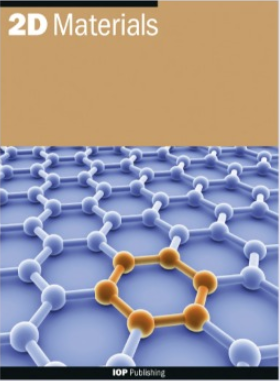二维过渡金属二粲化物中的粲空位的深度接受性质
IF 4.3
3区 材料科学
Q2 MATERIALS SCIENCE, MULTIDISCIPLINARY
引用次数: 0
摘要
半导体单层过渡金属二掺杂物(TMDs)中的瑀空位经常被用来解释各种现象,包括无意的 p 型和 n 型导电性,以及通过隧道或光学光谱测量的亚带隙缺陷水平。这些关于查尔根空位深浅性质的相互矛盾的解释,部分是由于之前用于解释实验观察结果的二维 TMD 半导体缺陷的第一原理计算存在缺陷。在此,我们报告了一系列单层 TMD 中胆原空位的混合密度泛函计算结果,正确地将热力学电荷转移水平引用到基带隙(而不是光带隙)。我们发现,查尔根空位是深度受体,不能导致 n 型或 p 型导电性。(0/-1)和(-1/-2)转变级都出现在带隙中,分别导致了顺磁电荷态 S=1/2 和 S = 1,采用的是准线-自旋表示法。我们讨论了 TMD 之间的带排列趋势,这可作为未来空位行为实验研究的指南。本文章由计算机程序翻译,如有差异,请以英文原文为准。
The deep-acceptor nature of the chalcogen vacancies in 2D transition-metal dichalcogenides
Chalcogen vacancies in the semiconducting monolayer transition-metal dichalcogenides (TMDs) have frequently been invoked to explain a wide range of phenomena, including both unintentional p-type and n-type conductivity, as well as sub-band gap defect levels measured via tunneling or optical spectroscopy. These conflicting interpretations of the deep versus shallow nature of the chalcogen vacancies are due in part to shortcomings in prior first-principles calculations of defects in the semiconducting two-dimensional TMDs that have been used to explain experimental observations. Here we report results of hybrid density functional calculations for the chalcogen vacancy in a series of monolayer TMDs, correctly referencing the thermodynamic charge transition levels to the fundamental band gap (as opposed to the optical band gap). We find that the chalcogen vacancies are deep acceptors and cannot lead to n-type or p-type conductivity. Both the (0/−1) and (−1/−2) transition levels occur in the gap, leading to paramagnetic charge states
S = 1 / 2 and S = 1, respectively, in a collinear-spin representation. We discuss trends in terms of the band alignments between the TMDs, which can serve as a guide to future experimental studies of vacancy behavior.
求助全文
通过发布文献求助,成功后即可免费获取论文全文。
去求助
来源期刊

2D Materials
MATERIALS SCIENCE, MULTIDISCIPLINARY-
CiteScore
10.70
自引率
5.50%
发文量
138
审稿时长
1.5 months
期刊介绍:
2D Materials is a multidisciplinary, electronic-only journal devoted to publishing fundamental and applied research of the highest quality and impact covering all aspects of graphene and related two-dimensional materials.
 求助内容:
求助内容: 应助结果提醒方式:
应助结果提醒方式:


